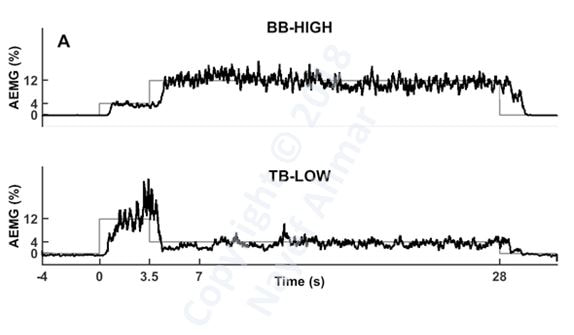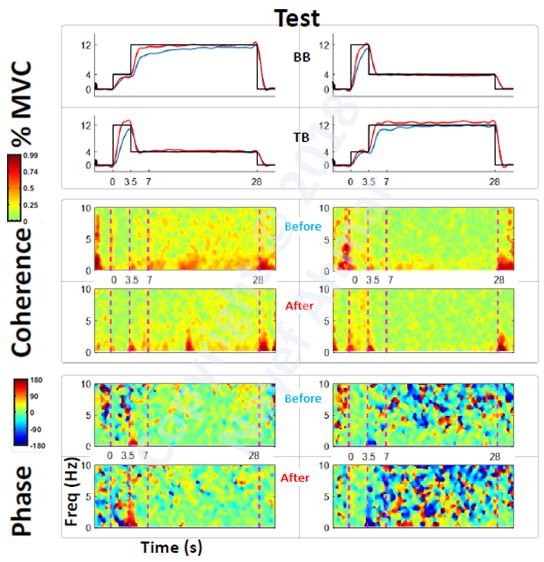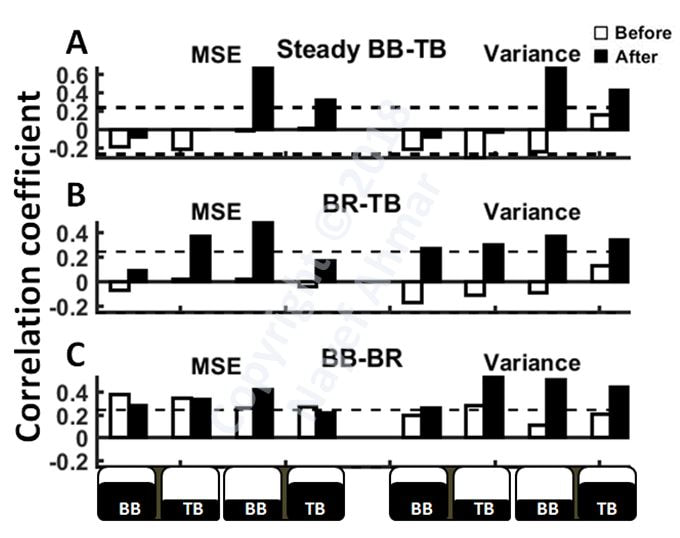Slow Intermuscular Oscillations are Associated with Cocontraction Steadiness

Voluntary muscle contraction often involves low-frequency correlated neural oscillations across muscles, which may degrade steady cocontraction between antagonistic muscles with distinct levels of activation per each muscle (unbalanced cocontraction). The purposes of the study were 1) to determine whether there is an association between the low-frequency correlated EMG oscillations and the performance of steady unbalanced cocontraction across individuals and 2) to determine whether a bout of out-of-phase cocontraction practice reduces the in-phase low-frequency correlated neural oscillations and improves the performance of steady unbalanced cocontraction.Healthy young adults were divided into three intervention groups: cocontraction, contraction, and control. All participants were tested for unbalanced steady cocontractions with antagonistic muscles about the elbow joint before and after a bout of intervention with the visual feedback of surface EMG. During the intervention period, the cocontraction group practiced an out-of-phase cocontraction, whereas the contraction group practiced agonist contractions.Mean squared error and variance of EMG amplitude were positively correlated with low-frequency EMG coherence <3 Hz across subjects, which became more prevalent after the intervention period. There was no specific effect of the cocontraction intervention on these variables.These findings suggest that individuals with less low-frequency correlated neural oscillations tend to perform steady cocontraction more skillfully, and the low-frequency correlated oscillations may not be acutely modulated by one bout of out-of-phase cocontraction practice.
Representative rectified and smoothed EMG (AEMG) signals of the biceps brachii (BB) and triceps brachii (TB) for visual feedback during the steady cocontraction test. Signals are overlaid to the targets in gray. Subjects contracted BB and TB muscles for two target pairs. Only one target pair is displayed.
Signals grand average during the cocontraction test. BB-HIGH (left column), and BB-LOW (right column) average across trials in 20 subjects: Top 2 rows, time series data (top: BB, bottom: TB; before and after practice); Rows 3&4, amplitude coherence between BB and TB before and after practice; similarly, rows 5&6 show phase coherence corresponding to rows 3&4. The x-axis is a measure of time between -4 and 32 s. BB: Biceps Brachii; TB: Triceps Brachii.
Correlation coefficient between performance variables (MSE and variance) and EMG coherence (A: BB-TB pair, B: BR-TB pair, C: BB-BR pair) before (open bars) and after (filled bars) the intervention period. On the x-axis, BB HIGH and TB LOW is one target pair, and BB LOW and TB HIGH is another target pair. Broken horizontal lines represent correlation coefficient at P = 0.05. LOW: 4%MVC target; HIGH: 12%MVC target; MSE, mean squared error. BB: Biceps Brachii; TB: Triceps Brachii; BR: Brachioradialis.
References
Ahmar, N. E., & Shinohara, M. (2017). Slow Intermuscular Oscillations are Associated with Cocontraction Steadiness. Medicine and science in sports and exercise, 49(9), 1955-1964.
Ahmar NE Slow Intermuscular Oscillations and strategies to Tango with a Robot. Doctoral dissertation 2018, Georgia Institute of Technology



